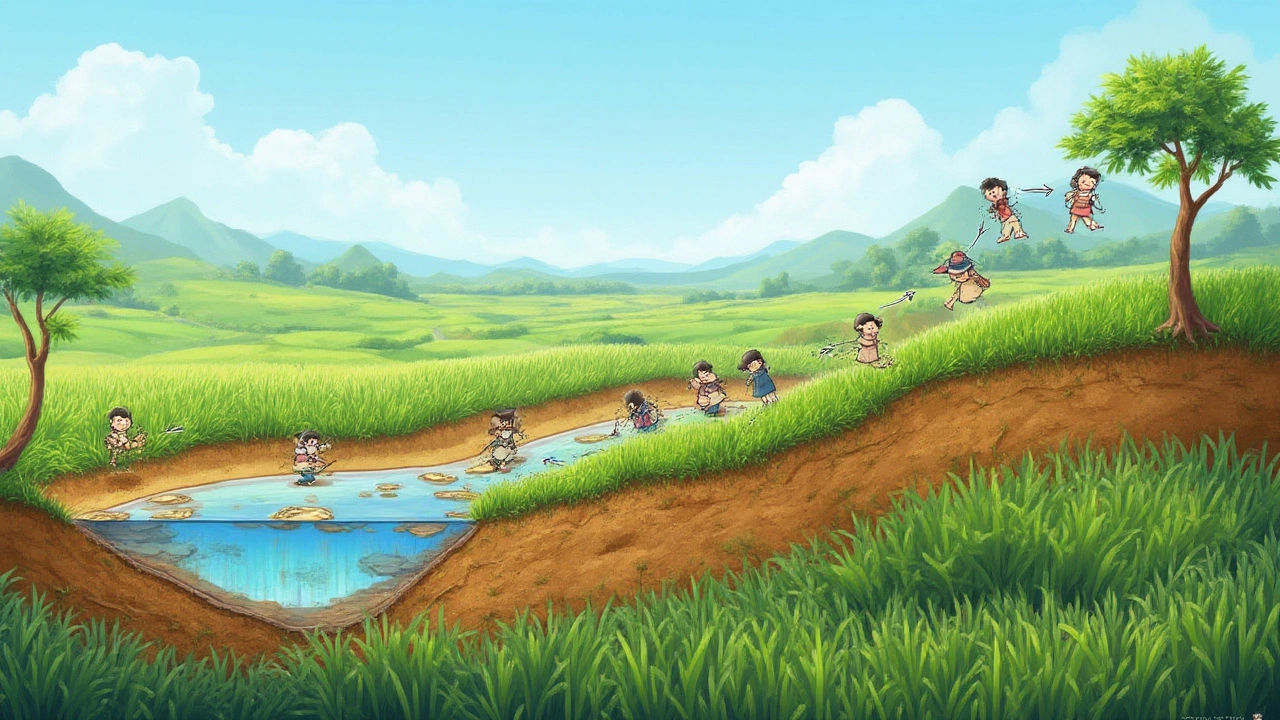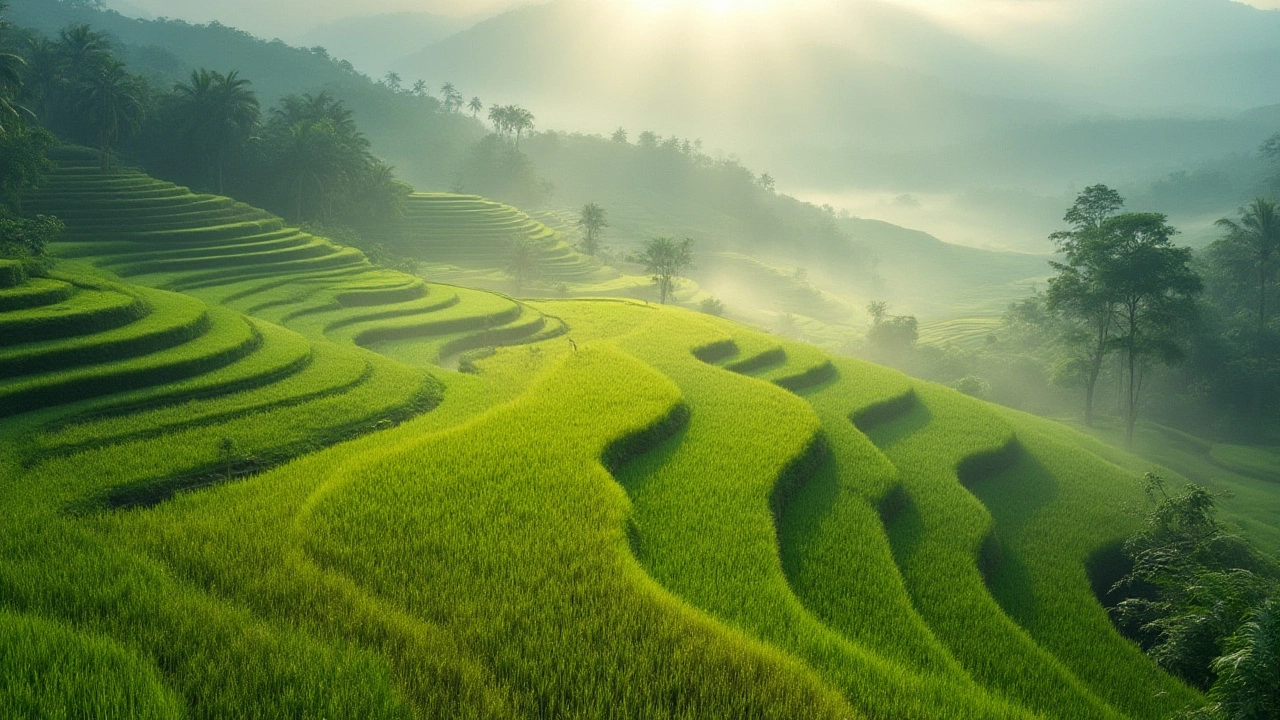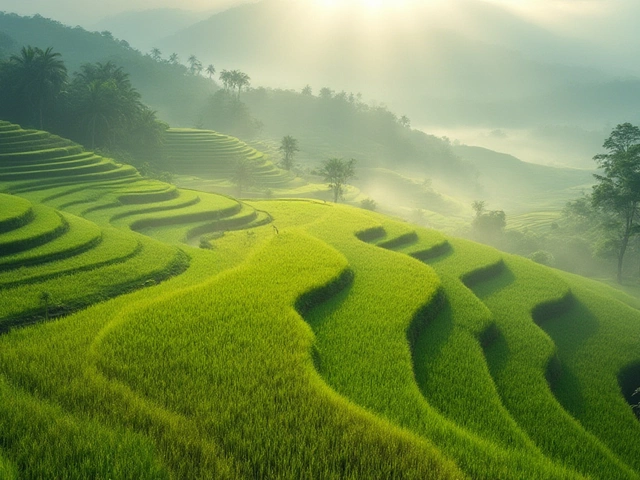Picture endless green fields shimmering in the sun, their calm beauty hiding a precise science below the surface. The ideal topography for growing rice isn't just a matter of picking a wet patch of land. From ancient terraces carved into Asian mountains to sprawling deltas along mighty rivers, every rice paddy is a careful blend of nature’s layout and human know-how. But not all land shapes work the same magic for rice. Let's dig into what makes some ground perfect, while others just don't work as well.
Why Topography Matters for Rice: Beyond Flat Land
The first thing to get straight: rice thrives when water sits where you put it. Most rice varieties are semi-aquatic—they need flooded fields for major chunks of their life cycle. That’s why folks talk so much about flat land when it comes to rice. Flatness makes flooding possible, but if it were just about finding a flat spot, rice would grow everywhere.
Flat valleys, broad river plains, and low-lying basins aren’t just easy to flood; they often collect rich sediments from rivers, bringing a constant buffet of nutrients. These are the places that launched rice farming thousands of years ago. In China’s Yangtze basin, in Vietnam’s Mekong Delta, and in India’s Ganges Plain, the rise of civilizations has always gone hand-in-hand with these geographic sweet spots. Want numbers? Over 90% of global rice is grown on these lowland fields, according to the International Rice Research Institute.
But the world isn’t all flat. What happens in hilly regions? That’s where humans get creative. In the Philippines and Indonesia, dramatic terraces turn mountain slopes into a step-by-step system for controlling water flow. Every terrace acts like a mini-dam, flattening just enough space for a flooded paddy but using the slope to move water down from one plot to the next. So while flatness is king, clever use of slopes can unlock surprising rice yields.
Still, extremes kill the deal. Land that’s too steep makes water control nearly impossible—one heavy rain and your precious soil washes away. On the other end, ground that’s too boggy can drown roots, especially if the water just sits there, stagnating and inviting disease. That’s why people say the best land for rice is "flat, low, but not swampy." It’s all about finding balance.
Ideal Land Features: The Recipe for a Great Rice Field
If you want to grow rice that has neighbors talking, it's not just about having a piece of ground. The best rice fields share common features, no matter the country or the local culture.
The sweet spot? Land that’s gently sloping or almost flat, sitting at a slightly lower elevation than the surrounding area. This position lets water flow in easily but not run out of control. These areas—natural depressions, floodplains, and river valleys—soak up rain without washing away your hard work.
For upland rice (which is less common, but still important in Africa and some parts of Asia), you’re looking for rolling country with gentle slopes—nothing too steep. These fields don’t get flooded. Instead, they rely on good rainfall and rich topsoil that hasn’t eroded away. Here, controlling drainage is more vital than holding water. Poorly-drained slopes may hold too much moisture in the wrong season, leading to root rot and stunted plants.
Modern rice farming often means reshaping the land. Farmers use laser leveling to create perfectly even fields—something that was nearly impossible before the 21st century. With flatness measured in fractions of a centimeter, water flows evenly, saving up to 40% in water use and boosting yields by 15% in some studies. If you want to see the future of rice, take a drone over a perfectly flat, laser-leveled paddy in Arkansas or Punjab—every square meter counts.
The soil underfoot matters too. Heavy clay soils hold water like a bathtub, perfect for standard paddy farming. Sandy soils, on the other hand, leak like a sieve and make water control a nightmare. But farmers get clever: they’ll line paddies with clay, use plastic sheeting, or even bury tarps to keep water where it’s needed.
To sum up: the best land for best topography for rice is mostly flat, gently sloping, and at a low elevation so you can channel water in (and, crucially, out) when needed. The soil has to hold that water—clay is king, sand is trouble, and everything in between is… workable with creativity. Rice isn’t picky about high or low temperature zones, but topography decides whether your plants swim or shrivel.

Water Management and Elevation: Friends or Foes?
Flooding is rice’s superpower and also its struggle. The real trick isn’t just flooding—it’s controlling the flood. That’s where topography becomes your ally or your biggest headache.
In the classic "paddy field" system, success is all about creating an even, shallow pool. Water depth should hover between 5 to 10 cm for most varieties, just enough to cover the plants’ roots and lower stems. Too deep, and seedlings drown; too shallow, and weeds take over. Flatness ensures every corner of your field gets the same treatment. Research at the International Water Management Institute says that properly-levelled fields cut labor by 30% and let you control weeds more easily than uneven plots.
Now, consider elevation. Lower fields naturally gather water, which helps when you want to flood. In wet climates or during the rainy season, though, low spots might flood too much—think Bangladesh’s coastal plains, which disappear under meters of water during monsoon. Here, levees and drainage ditches are the difference between a rice harvest and a wet mess. In fact, communities like the farmers in the Ebro Delta in Spain have managed their fields with floodgates and pumps for centuries, customizing water levels almost by the hour.
Higher elevations mean less water risk but come with their own problems. You have to bring water uphill—no small feat if you’re using buckets, much less if you’re irrigating hundreds of hectares. That’s why irrigated terraces, like those seen in Bali, have networks of canals, bamboo pipes, and centuries-old water-sharing agreements called "subak." Upland or rainfed fields, sitting above reliable water sources, must be chosen for good drainage—not too boggy, not too dry.
What about risks? Too much water can ruin the crop. Poorly-drained depressions can turn from a farmer’s dream into a mosquito paradise. But in places like California’s Central Valley, where rice fields are flooded at just the right moment, the land doesn’t just yield good rice—it provides critical wildlife habitat for millions of migratory birds. Who would’ve guessed rice farmers are also accidental conservationists?
Check out some numbers that show just how much water and elevation matter in rice farming:
| Field Type | Elevation (meters above sea level) | Typical Water Depth (cm) | Yields (tons/ha) |
|---|---|---|---|
| Lowland Paddy | 0-200 | 5-12 | 5-7 |
| Upland Rainfed | 200+ | None | 1-3 |
| Terraced Rice | Varies | Varies | 3-6 |
Whether your patch of earth is tucked in a river bend or cut into a hillside, water—and the way land shapes water—sets the stage for everything else.
Rice Landscape Inspirations: Famous Places and Smart Solutions
Some rice landscapes are so iconic you can spot them from space. If you ever see those endless, stepped fields stretching up a foggy hillside in a travel documentary—that’s the ancient Ifugao terraces of the Philippines. Built over 2,000 years ago, these terraces catch rain and channel streams down through a dizzying staircase of mini-paddies. The result? Reliable food in the middle of mountains where flat land just doesn't exist.
Move to the Mekong Delta, and you’ll see another genius adaptation. Here, rice fields flood naturally with the seasonal river pulse. Instead of fighting the water, locals time their planting to the floods. When the muddy floodwaters recede, rice shoots rise everywhere, making use of nutrient-rich silt left behind. These delta fields produce triple rice harvests a year—no fertilizers needed, nature does the heavy lifting.
In California, rice farmers deal with the opposite problem: floods are rare, water must be imported and tightly controlled. So, laser-levelled fields, deep clay soils, and clever irrigation turn the relatively flat Sacramento Valley into the US’s rice bowl. Farmers even use satellites and smartphone apps to perfect their water schedule—if your phone tells you a field is unevenly flooded, pumps get switched on or off before a single stem wilts.
Don’t ignore tricks from small farmers, either. In Madagascar’s highlands, where land is short, they use “SRI” (System of Rice Intensification)—a way of planting fewer seeds per cluster, allowing more air and water to reach every plant. This shows that even if your land isn’t textbook-perfect, smart tweaks to your layout and water management can make a big difference.
- If you live in a flood-prone area, copy the semi-aquatic approach: raised pathway grids with deliberately flooded lower plots.
- On a hillside? Terrace your land. Small, stone walls hold back soil and water, giving each rice patch a fighting chance.
- Stuck with sandy or rocky ground? Invest in lining paddy bottoms with clay or plastic sheets. It’s more labor, but your water loss will drop noticeably.
- No access to pumps? Gravity-fed irrigation, time-tested in Asia and Africa, uses sloped canals to move water with zero machines.
The bottom line: people have carved great rice fields from just about every corner of the Earth, but they always start by reading the land. Look at what nature gives you, then work with it (not against it).

Smart Tips for Choosing or Improving Rice-Growing Land
Maybe you’re mapping your first field, or maybe you want to get just one more sack from each hectare. Either way, here are some straightforward tips any rice grower—or future rice grower—can use:
- Scout the lay of the land during rainy season. Walk the edges—see where water pools, where it drains too fast, which spots look like natural basins.
- If possible, go for fields that are already mostly flat or in broad shallow valleys. These need the least work for reliable flooding.
- If land is sloped, check if it can be terraced with reasonable effort. Start small—a single terrace can teach you plenty about managing water and soil.
- Test the soil’s ability to hold water. Dig a shallow hole and flood it; see how long the water stays. If it drains in an hour, you’ll need major work or soil amendments. Clay-rich patches usually hang tight to water.
- Be honest about your water access. Fields downstream from rivers or ponds usually win. If irrigation is possible, check if the flow can easily reach the whole patch without much pumping.
- Always leave room for drainage. Especially if your land is low, build ditches or simple channels so you can let floodwater out in a hurry.
- Consider the modern: laser-leveling, satellite water sensors, or just a good long carpenter’s level can help you spot dips and humps that water will either pool in or skip over.
- Ask neighbors for their tricks. Sometimes, local tweaks—like planting on small mounds or timing the first flood—are what make the difference between an average harvest and a bumper crop.
Last tip? Think of your rice field as a living system, not just a plot for planting. How water enters, moves, pools, and leaves is as important as the seed you choose. If you get the topography right, just about everything else falls into place. That's the deeply satisfying, endlessly surprising world of rice growing—one patch of ground at a time.


